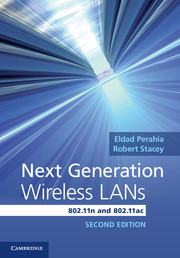Book contents
- Frontmatter
- Contents
- Foreword
- Preface to the first edition
- Preface to the second edition
- List of abbreviations
- Chapter 1 Introduction
- Part I Physical layer
- Chapter 2 Orthogonal frequency division multiplexing
- Chapter 3 MIMO/SDM basics
- Chapter 4 PHY interoperability with 11a/g legacy OFDM devices
- Chapter 5 High throughput
- Chapter 6 Robust performance
- Chapter 7 Very High Throughput PHY
- Part II Medium access control layer
- Part III Transmit beamforming, multi-user MIMO, and fast link adaptation
- Index
- References
Chapter 7 - Very High Throughput PHY
from Part I - Physical layer
Published online by Cambridge University Press: 05 June 2013
- Frontmatter
- Contents
- Foreword
- Preface to the first edition
- Preface to the second edition
- List of abbreviations
- Chapter 1 Introduction
- Part I Physical layer
- Chapter 2 Orthogonal frequency division multiplexing
- Chapter 3 MIMO/SDM basics
- Chapter 4 PHY interoperability with 11a/g legacy OFDM devices
- Chapter 5 High throughput
- Chapter 6 Robust performance
- Chapter 7 Very High Throughput PHY
- Part II Medium access control layer
- Part III Transmit beamforming, multi-user MIMO, and fast link adaptation
- Index
- References
Summary
The major new PHY features and enhancements for Very High Throughput (VHT) in 802.11ac include wider bandwidth, modulation/coding/spatial streams, and downlink multi-user (MU) MIMO. The channel bandwidth in 802.11ac was expanded to include 80 MHz and 160 MHz waveforms. With 80 MHz and four spatial streams the maximum data rate is 1733.3 Mbps and with 160 MHz and four spatial streams the maximum data rate is 3466.7 Mbps using the newly defined 256-QAM modulation. A new non-contiguous 80+80 MHz waveform design is also included in VHT to better fit a 160 MHz transmission into the available spectrum. The maximum number of spatial streams increases from four in 802.11n to eight. With 160 MHz and eight spatial streams, the maximum VHT data rate is 6933.3 Mbps. VHT includes additional smaller increases to data rate with 256-QAM. With the addition of downlink multi-user (MU) MIMO to the 802.11 standard, we now have a single user (SU) and MU packet structure. As we will see, these two packet structures have a common VHT preamble format. This is different from 802.11n, which has both a MF and GF preamble format. This chapter will review the new packet structure and waveform for VHT designed in 802.11ac to support the new features for single user transmission. MU transmission will be addressed in Chapter 14. We will also review minor modifications to features borrowed from 802.11n, including STBC and LDPC.
Channelization
The channelization for 802.11ac is the same as 802.11n for 20 and 40 MHz, with the addition of channel 144 as illustrated in Figure 7.1. Originally, the 802.11 channel numbers ended at 140 in the 5470–5725 MHz band to leave guard band between it and the 5725–5850 band. However, in recent discussions with the FCC, they indicated that overlap between 5150–5250 MHz and 5250–5350 MHz bands and 5470–5725 MHz and 5725–5850 bands is permitted. Note that regulations regarding maximum transmit power and radar detection must be observed in the respective bands. This new guideline allowed for channel 144 and also for 160 MHz channels.
- Type
- Chapter
- Information
- Next Generation Wireless LANs802.11n and 802.11ac, pp. 182 - 218Publisher: Cambridge University PressPrint publication year: 2013
References
- 1
- Cited by



